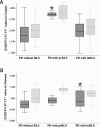A Four-Year Longitudinal Study on Restless Legs Syndrome in Parkinson Disease
- PMID: 26564123
- PMCID: PMC4712388
- DOI: 10.5665/sleep.5452
A Four-Year Longitudinal Study on Restless Legs Syndrome in Parkinson Disease
Abstract
Study objectives: Restless legs syndrome (RLS) prevalence estimates range from 0% to 52% in Parkinson disease (PD), but the causal relationship between the two disorders is still debated. The present study aims to evaluate RLS prevalence in de novo PD subjects, its incidence during the first 4 years from diagnosis, and possible relationships with clinical, laboratory, and neuroradiological data.
Methods: One hundred nine newly diagnosed, drug-naïve PD subjects were evaluated at the time of PD diagnosis, and after 2- and 4-years. RLS diagnosis was performed with the RLS Diagnostic Index at each visit. Motor features, additional non-motor symptoms (NMS), and concomitant dopaminergic and nondopaminergic treatments were also gathered. Moreover, at baseline, 65 subjects were randomly selected to undergo a FP-CIT SPECT to study dopamine transporter availability.
Results: RLS prevalence rose from 4.6% at baseline evaluation to 6.5% after 2 years and to 16.3% after 4 years (P = 0.007). A multinomial logistic stepwise regression model selected NMS Questionnaire items more likely to be associated with RLS at diagnosis (insomnia, OR = 15.555; P = 0.040) and with occurrence of RLS during follow-up (dizziness, OR = 1.153; P = 0.022; and daytime sleepiness; OR = 9.557; P = 0.001), as compared to patients without RLS. Older age was more likely associated to increased RLS occurrence during follow-up in a random effect logistic regression model (OR = 1.187; P = 0.036). A multinomial logistic stepwise model found increased dopaminergic transporter availability of affected caudate and putamen to be more likely associated with RLS presence at diagnosis (n = 5; OR = 75.711; P = 0.077), and RLS occurrence during follow-up (n = 16; OR = 12.004; P = 0.059), respectively, as compared to patients without RLS (n = 88).
Conclusions: RLS is present since PD diagnosis, and increases in prevalence during the course of PD. PD subjects with RLS have higher age at PD onset, more preserved dopaminergic pathways, and worse sleep and cardiovascular disturbances.
Keywords: DAT; Parkinson; RLS; SPECT; progression; restless; sleep.
© 2016 Associated Professional Sleep Societies, LLC.
Figures


References
-
- Allen R, Picchietti D, Hening W, et al. Restless legs syndrome: diagnostic criteria, special considerations, and epidemiology. A report from the restless legs syndrome diagnosis and epidemiology workshop at the National Institutes of Health. Sleep Med. 2003;4:101–19. - PubMed
-
- Gómez-Esteban JC, Zarranz JJ, Tijero B, et al. Restless legs syndrome in Parkinson's disease. Mov Disord. 2007;22:1912–6. - PubMed
-
- Peralta CM, Frauscher B, Seppi K, et al. Restless legs syndrome in Parkinson's disease. Mov Disord. 2009;24:2076–80. - PubMed
-
- Ondo WG, Vuong KD, Jankovic J. Exploring the relationship between Parkinson disease and restless legs syndrome. Arch Neurol. 2002;59:421–4. - PubMed
Publication types
MeSH terms
Substances
LinkOut - more resources
Full Text Sources
Other Literature Sources
Medical

